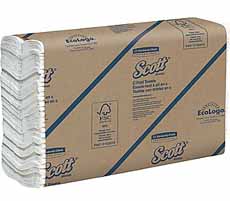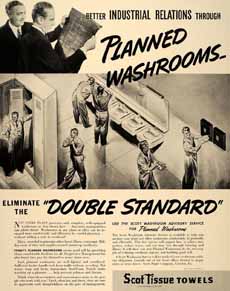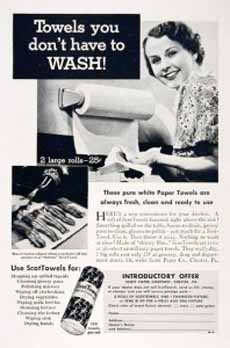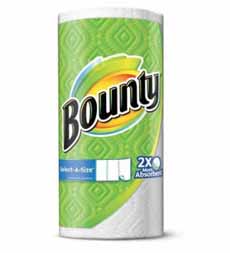FOOD HISTORY: The Accidental Invention Of Paper Towels
|
[4] We can’t live [happily] without them: Bounty Select-A-Size paper towels (photo courtesy Procter & Gamble). |
We have always been fussy about the quality of our paper products: facial tissue, paper napkins, paper towels and toilet tissue. We’d give up cappuccino if we could only afford either coffee or paper goods. Our paper towels of choice are the best-absorbent Bounty Towels (introduced in 1965 by Procter & Gamble). Since we’re frequently mopping up kitchen spills, we tried to reduce wasteful consumption, actually tearing the full sheets in half to wipe up small spills. When Bounty introduced Select-A-Size (photo #4)—one sheet perforated in thirds for those very small spills—we were in heaven. Recently, putting away the 15-pack we purchased, we thought to thank the inventor of paper towels. But who was that? And when was it? Scott Paper Company was founded by brothers E. Irvin and Clarence Scott in Philadelphia, in 1879. They debuted Scott Brand Tissue, toilet tissue with 1,000 sheets per roll, at 10 cents per roll. It was initially considered a medical item. Print ads were used to increase awareness and address embarrassment. In 1907, Arthur Scott, son of E. Irvin Scott and then head of the company, had a big problem: An entire railroad car full of paper, unloaded at his plant, had been rolled too thick for toilet tissue. Should he send the whole carload back? He recalled hearing about teacher in the city school system who had developed a novel concept to help fight colds: She gave students with runny noses a small piece of soft paper to use after washing their hands. That way, the cloth roller towels in the washrooms would not become contaminated with germs. The light bulb turned on: Scott ordered the thick paper perforated into small towel-size sheets and sold them as disposable paper towels—the kind you still pull out of metal dispensers in public washrooms (photo #1). Named Sani-Towel, and sold the paper towels to hotels, restaurants, and railroad stations for use in their washrooms (photo #2). The metal towel dispenser of paper towels vied with the roller towel, the earlier solution: a metal cabinet housing a continuous towel that people pulled down (to find a clean piece). That towel was washed and returned to the roller. In 1931, Scott saw a use for Sani-Towels in kitchens, and introduced the world’s first “paper towels”—a sheet a perforated, soft paper, on a roll in sheets of 13” x 8” (source). To housewives used to washing kitchen rags and other cleaning cloths, it was a non-event. They had a hard time grasping the concept of “Towels you don’t have to wash” (photo #3).Dishes still needed to be dried with towels. It would take many years before paper towels replaced cloth towels for kitchen use, but they resulted in the creation of a large new grocery category (and where would be be without them?). Today they are now the leading manufacturer of paper towels. Paper towels are second only to toilet paper in the tissue paper category. The U.S. is the country with the highest consumption of paper towels and other tissue products, with approximately 53 pounds per capita per year. That’s 50% higher than in Europe and nearly 500% higher than in Latin America (source: Wikipedia). |
|
|
|
||






